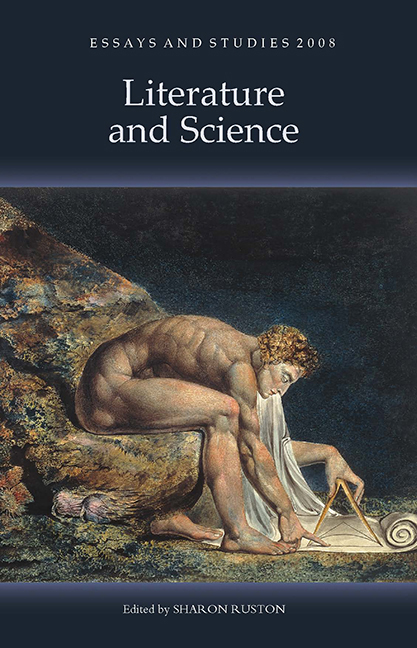Book contents
- Frontmatter
- Contents
- List of Illustrations
- Acknowledgements
- Notes on Contributors
- Introduction
- 1 From Popular Science To Contemplation: The Clouds Of The Cloud Of Unknowing
- 2 ‘Dreams And Plain Dotage’: The Value Of The Birth Of Mankind (1540–1654)
- 3 Natural Rights And Natural History In Anna Barbauld And Mary Wollstonecraft
- 4 George Eliot, Geometry And Gender
- 5 On The Back Of The Light Waves: Novel Possibilities In The ‘Fourth Dimension’
- 6 Le Fanu's ‘Carmilla’, Ireland, And Diseased Vision
- 7 Evolution, Literary History And Science Fiction
- 8 ‘The Luxury Of Storytelling’: Science, Literature And Cultural Contest In Ian Mcewan's Narrative Practice
- Index
1 - From Popular Science To Contemplation: The Clouds Of The Cloud Of Unknowing
Published online by Cambridge University Press: 12 February 2019
- Frontmatter
- Contents
- List of Illustrations
- Acknowledgements
- Notes on Contributors
- Introduction
- 1 From Popular Science To Contemplation: The Clouds Of The Cloud Of Unknowing
- 2 ‘Dreams And Plain Dotage’: The Value Of The Birth Of Mankind (1540–1654)
- 3 Natural Rights And Natural History In Anna Barbauld And Mary Wollstonecraft
- 4 George Eliot, Geometry And Gender
- 5 On The Back Of The Light Waves: Novel Possibilities In The ‘Fourth Dimension’
- 6 Le Fanu's ‘Carmilla’, Ireland, And Diseased Vision
- 7 Evolution, Literary History And Science Fiction
- 8 ‘The Luxury Of Storytelling’: Science, Literature And Cultural Contest In Ian Mcewan's Narrative Practice
- Index
Summary
THIS ARTICLE deals with the clouds which give the medieval mystical treatise The Cloud of Unknowing its name. Rather than being solely metaphorical, the clouds of forgetting (beneath the contemplative) and unknowing (above and affected by light) have much in common with clouds as explained by contemporary books of popular science, such as Sidrak and Bokkus and John Trevisa's On the Properties of Things. This demonstrates how these medieval texts exemplify the blending of scientific and literary modes recently advocated by Gould (2003). In general, these religious and scientific texts combine factual observation, deduction and religious interpretation with direct human response to the natural world to arrive at a whole understanding of the physical and metaphysical world. In this these works share common ground with current green thinking. Broadly speaking, greens promote the value of the non-human in terms which do not require ‘nature’ to be subservient to, or have existence solely within, a human value-system.
Clouds appeal: witness the popularity of Richard Hamblyn's The Invention of Clouds (2001) and Gavin Pretor-Pinney's The Cloudspotter's Guide (2006). Both can be classed as ‘popular science’ since they address a general audience by providing hard scientific (meteorological) information alongside lighter matter: in Hamblyn's case biography, in Pretor-Pinney's joyous appreciation of natural phenomena. Each attests the enduring appeal of clouds as fascinating but somehow ultimately unknowable, despite meteorology's careful categorization of their causes, forms and effects. These books highlight the science, but they also maintain the clouds of our imaginations both as white puffs (‘our fluffy friends’) and dark banks (cumulonimbus is ‘the Darth Vader of clouds’) (Pretor-Pinney 2006, 45). They also reinforce an association of clouds with metaphor which seems almost automatic and is perhaps linked to the habit of seeing shapes in clouds like Polonius (Hamlet 3.3.366–72) or Antony in Antony and Cleopatra (4.12.1–22). Hamblyn's subtitle, How an Amateur Meteorologist Forged the Language of the Skies, is in a similar vein while his prose asserts an explicit link between clouds and language in terms which make claims for meteorology as a literary form as much as a science:
Yet meteorology is not an exact science. It is, rather, a search for narrative order among events governed not by laws alone but by the shapeless caprices of the atmosphere.
- Type
- Chapter
- Information
- Literature and Science , pp. 13 - 34Publisher: Boydell & BrewerPrint publication year: 2008



